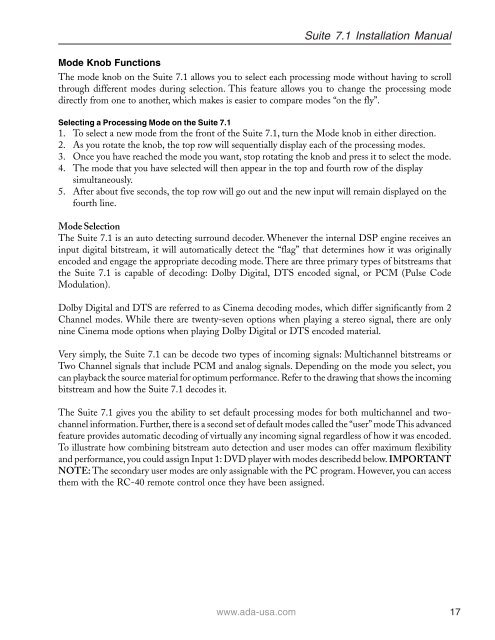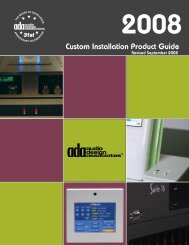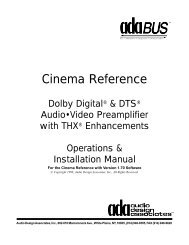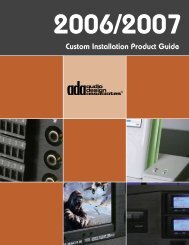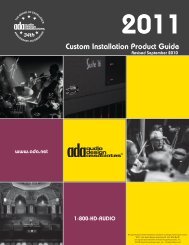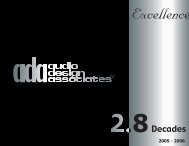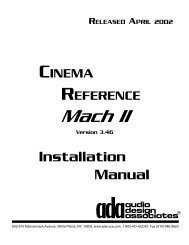Suite 7.1 Manual - Audio Design Associates
Suite 7.1 Manual - Audio Design Associates
Suite 7.1 Manual - Audio Design Associates
Create successful ePaper yourself
Turn your PDF publications into a flip-book with our unique Google optimized e-Paper software.
<strong>Suite</strong> <strong>7.1</strong> Installation <strong>Manual</strong><br />
Mode Knob Functions<br />
The mode knob on the <strong>Suite</strong> <strong>7.1</strong> allows you to select each processing mode without having to scroll<br />
through different modes during selection. This feature allows you to change the processing mode<br />
directly from one to another, which makes is easier to compare modes “on the fly”.<br />
Selecting a Processing Mode on the <strong>Suite</strong> <strong>7.1</strong><br />
1. To select a new mode from the front of the <strong>Suite</strong> <strong>7.1</strong>, turn the Mode knob in either direction.<br />
2. As you rotate the knob, the top row will sequentially display each of the processing modes.<br />
3. Once you have reached the mode you want, stop rotating the knob and press it to select the mode.<br />
4. The mode that you have selected will then appear in the top and fourth row of the display<br />
simultaneously.<br />
5. After about five seconds, the top row will go out and the new input will remain displayed on the<br />
fourth line.<br />
Mode Selection<br />
The <strong>Suite</strong> <strong>7.1</strong> is an auto detecting surround decoder. Whenever the internal DSP engine receives an<br />
input digital bitstream, it will automatically detect the “flag” that determines how it was originally<br />
encoded and engage the appropriate decoding mode. There are three primary types of bitstreams that<br />
the <strong>Suite</strong> <strong>7.1</strong> is capable of decoding: Dolby Digital, DTS encoded signal, or PCM (Pulse Code<br />
Modulation).<br />
Dolby Digital and DTS are referred to as Cinema decoding modes, which differ significantly from 2<br />
Channel modes. While there are twenty-seven options when playing a stereo signal, there are only<br />
nine Cinema mode options when playing Dolby Digital or DTS encoded material.<br />
Very simply, the <strong>Suite</strong> <strong>7.1</strong> can be decode two types of incoming signals: Multichannel bitstreams or<br />
Two Channel signals that include PCM and analog signals. Depending on the mode you select, you<br />
can playback the source material for optimum performance. Refer to the drawing that shows the incoming<br />
bitstream and how the <strong>Suite</strong> <strong>7.1</strong> decodes it.<br />
The <strong>Suite</strong> <strong>7.1</strong> gives you the ability to set default processing modes for both multichannel and twochannel<br />
information. Further, there is a second set of default modes called the “user” mode This advanced<br />
feature provides automatic decoding of virtually any incoming signal regardless of how it was encoded.<br />
To illustrate how combining bitstream auto detection and user modes can offer maximum flexibility<br />
and performance, you could assign Input 1: DVD player with modes describedd below. IMPORTANT<br />
NOTE: The secondary user modes are only assignable with the PC program. However, you can access<br />
them with the RC-40 remote control once they have been assigned.<br />
www.ada-usa.com 17


